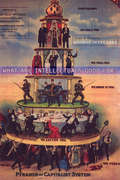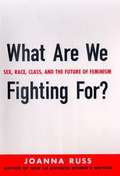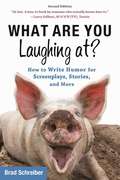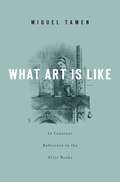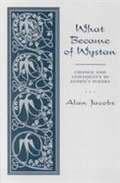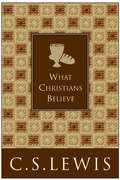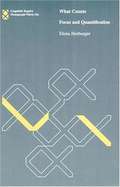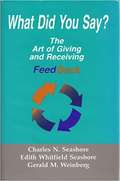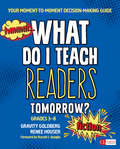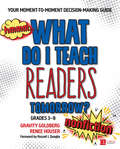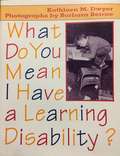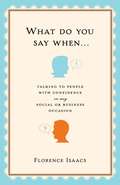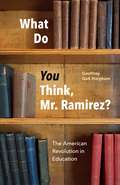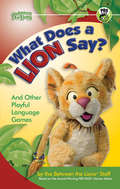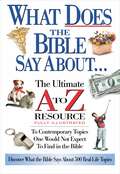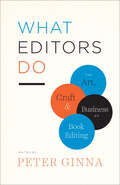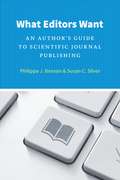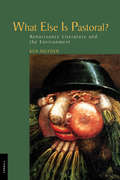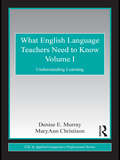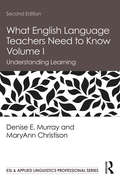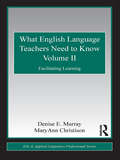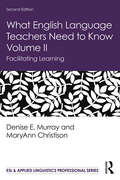- Table View
- List View
What Are Intellectuals Good For?: Essays & Reviews
by George ScialabbaEssays and reviews concentrating on politics, economics, sociology and culture. When George’s What Are Intellectuals Good For? appeared it was greeted by an NPR review that sang the book’s praises. Pressed Wafer was totally unprepared for the blizzard of orders that came from Amazon. We hustled out and purchased the George Scialabba Two Wheeler to cart the books to the Post Office! The current cliché is that America has no public intellectuals. Every sentence George writes gives the lie to this bit of lazy journalese.
What Are We Fighting For?: Sex, Race, Class and the Future of Feminism
by Joanna RussA study of the future of feminism calls for a return to the radical roots of feminism's direct political struggle during the 1960s and early 1970s and a move away from the de-politicized focus on women's psychology and personal relations of today.
What Are You Laughing At?: How to Write Humor for Screenplays, Stories, and More
by Brad Schreiber Chris Vogler“People have forgotten how to be funny,” says Chris Vogler in his foreword to What Are You Laughing at? Luckily, experienced and award-winning humor writer Brad Schreiber is here to remind us all how it’s done. If laughter is the best medicine, be prepared to feel fit as a fiddle after perusing these pages. Brad’s clever wit and well-timed punch lines are sure to leave you grasping your sides, while his wise advice will ensure that you’re able to follow in his comedic footsteps.With more than seventy excerpts from such expert prose and screenwriters as Woody Allen, Steve Martin, and Kurt Vonnegut Jr., as well as unique writing exercises for all situations, this comprehensive tutorial will teach you how to write humor prose for any literary form, including screenwriting, story writing, theater, television, and audio/radio. Additionally, readers are given sage advice on different tactics for writing comedic fiction versus comedic nonfiction. Some of the topics discussed include:Life experience versus imaginationHow to use humor to develop theme/setting, character, and dialogueRhythm and sound of wordsVulgarity and bad tasteHow to market your humor prose in the digital marketThoroughly revised and updated, and with new information on writing short, humorous films, What Are You Laughing at? is your endless source to learning the art of comedy.
What Art Is Like, in Constant Reference to the Alice Books
by Miguel TamenThis comic, serious inquiry into the nature of art takes its technical vocabulary from Alice’s Adventures in Wonderland and Through the Looking-Glass. It is ridiculous to think of poems, paintings, or films as distinct from other things in the world, including people. Talking about art should be contiguous with talking about other relevant matters.
What Became of Wystan: Change and Continuity in Auden's Poetry
by Alan JacobsIn this lucid and balanced treatise, Alan Jacobs reveals the true parameters of Auden's change after his move to America in 1939. By carefully examining poems that represent transitional moments in Auden's thinking, he demonstrates the steady qualities of thought and expression found throughout Auden's poetry and shows how, in great art, as in great minds, change and continuity may powerfully coexist.
What Can You Do?
by Linda Lott Ginger NielsonThe fun and excitement of English and Language Arts learning continues in Grade 2 of Reading Street. This comprehensive and dynamic curriculum for homeschooling is geared toward young children who have some foundational English and Language Arts knowledge and are ready to strengthen their skills. Comprised of engaging activities, challenging content and weekly quizzes, Reading Street: Grade 2 is the next step in your child's path toward becoming a lifelong learner and reader. As with all Reading Street products, the Grade 2 system is formatted to help students meet certain age-appropriate goals. After completing this English and Language Arts homeschool program, your child should be able to: Read and comprehend two-syllable words. Identify common prefixes (such as pre-, un-, or re-) and suffixes (such as -able, -ad and -er). Correct mistakes made when reading out loud. Read books with two or more chapters. Understand the structure of stores (i. e. beginning, middle and end). Start selecting reading materials based on his/her own interests. Identify the "who," "what," "when," "where," "why" and "how" of the text. While the goals of second Grade English and Language Arts are numerous, Reading Street will help you craft engrossing lessons. Your child will garner important English and Language Arts skills while completing a workbook, reading stories and poems, and taking assessments. Planning these lessons will be easier than ever, as all Reading Street systems are broken down into weekly Big Ideas. All the work your child does on a given week is formulated around that single concept for an organized and challenging curriculum. With six easy-to-follow units, Reading Street: Grade 2 is the perfect tool for homeschooling parents. Your child will enjoy the reading selections and activities, and you'll love to see your student growing into a knowledgeable individual. We're confident that this product is the right one for you. For more information on the specific materials found in Grade 2 of Reading Street, check out the Features and Benefits page.
What Christians Believe
by C. S. LewisThe Essentials Explained Master storyteller and essayist C. S. Lewis here tackles the central questions of the Christian faith: Who was Jesus? What did he accomplish? What does it mean for me? In these classic essays, which began as talks on the BBC during World War II, Lewis creatively and simply explains the basic tenets of Christianity. Taken from the core section of Mere Christianity, the selection in this gift edition provides an accessible way for more people to discover these timeless truths. For those looking to remind themselves of the things they hold true, or those looking for a snapshot of Christianity, this book is a wonderful introduction to the faith.
What Counts: Focus and Quantification
by Elena HerburgerIn What Counts, Elena Herburger considers the effects of focus on interpretation. She investigates how focus affects the pragmatics and truth conditions of a sentence by rearranging its quantificational structure. Adopting a neo-Davidsonian stance, Herburger claims that various pragmatic and truth-conditional effects of focus sustain a uniform explanation if focus is viewed as imposing structure on otherwise unrestricted quantification. Phenomena discussed include "free" focus, the interaction between focus and negation, the quantificational structure of adverbs of quantification, the semantics of onlyand even, and the differences between weak and strong determiners. One of Herburger's aims is to show that a simple semantics, without reliance on such notions as semantic presupposition, can account for the truth-conditional and pragmatic effects of focus. The book will be of interest to anyone exploring the syntax-semantics interface and current theories of quantification. Linguistic InquiryMonograph No. 36
What Did You Say: The Art of Giving and Receiving Feedback
by Charles N. Seashore; Edith Whitfield Seashore; Gerald M. WeinbergFacts and Fantasies about Feedback; Giving Feedback; Receiving Feedback; Feedback as a Process of Interaction; Facilitating Improved Interactions; Epilogue: Feedback Artistry.
What Do I Teach Readers Tomorrow? Fiction, Grades 3-8: Your Moment-to-Moment Decision-Making Guide (Corwin Literacy)
by Gravity Goldberg Renee W. HouserStreamline formative assessment for readers in just minutes a day With What Do I Teach Readers Tomorrow? Fiction, discover how to move your readers forward with in-class, actionable formative assessment. The authors provide a proven, 4-step process—lean in, listen to what readers say, look at what they write, and assess where they need to go next. Next-step resources for whole-class, small-group, and one-on-one instruction, include Reproducible Clipboard Notes pages for quick assessments More than 30 lessons to get you started Reading notebook entries and sample classroom conversations Online video clips of Renee and Gravity teaching and debriefing
What Do I Teach Readers Tomorrow? Fiction, Grades 3-8: Your Moment-to-Moment Decision-Making Guide (Corwin Literacy)
by Gravity Goldberg Renee W. HouserStreamline formative assessment for readers in just minutes a day With What Do I Teach Readers Tomorrow? Fiction, discover how to move your readers forward with in-class, actionable formative assessment. The authors provide a proven, 4-step process—lean in, listen to what readers say, look at what they write, and assess where they need to go next. Next-step resources for whole-class, small-group, and one-on-one instruction, include Reproducible Clipboard Notes pages for quick assessments More than 30 lessons to get you started Reading notebook entries and sample classroom conversations Online video clips of Renee and Gravity teaching and debriefing
What Do I Teach Readers Tomorrow? Nonfiction, Grades 3-8: Your Moment-to-Moment Decision-Making Guide (Corwin Literacy)
by Gravity Goldberg Renee W. HouserStreamline formative assessment for readers in just minutes a day With What Do I Teach Readers Tomorrow? Nonfiction, discover how to move your readers forward with in-class, actionable formative assessment. The authors provide a proven, 4-step process—lean in, listen to what readers say, look at what they write, and assess where they need to go next. Next-step resources for whole-class, small-group, and one-on-one instruction, include Reproducible Clipboard Notes pages for quick assessments More than 30 lessons to get you started Reading notebook entries and sample classroom conversations Online video clips of Renee and Gravity teaching and debriefing
What Do I Teach Readers Tomorrow? Nonfiction, Grades 3-8: Your Moment-to-Moment Decision-Making Guide (Corwin Literacy)
by Gravity Goldberg Renee W. HouserStreamline formative assessment for readers in just minutes a day With What Do I Teach Readers Tomorrow? Nonfiction, discover how to move your readers forward with in-class, actionable formative assessment. The authors provide a proven, 4-step process—lean in, listen to what readers say, look at what they write, and assess where they need to go next. Next-step resources for whole-class, small-group, and one-on-one instruction, include Reproducible Clipboard Notes pages for quick assessments More than 30 lessons to get you started Reading notebook entries and sample classroom conversations Online video clips of Renee and Gravity teaching and debriefing
What Do You Mean I Have a Learning Disability?
by Kathleen M. DwyerTen-year-old Jimmy just accepts the fact that other kids can do things better than he can. It's always been that way--but now Jimmy is starting to think there must be a reason. One day he whispers to his cat, "I'm so stupid. I know I am." This true story has a happy ending. One of Jimmy's teachers encouraged his parents to have Jimmy tested, and it turned out that he had a learning disability. Hard work and perseverance, and the support of his family, helped Jimmy overcome his disability. For children who are learning disabled, and for their families and friends, this inspiring book offers encouragement and support in a shared effort.
What Do You Say When . . .: Talking to People with Confidence on Any Social or Business Occasion
by Florence IsaacsHave you ever walked alone into a room of chattering people and felt nervous? Is the idea of attending a wedding or job interview where you won't know many people intimidating? The art of conversation is a necessary skill for navigating life’s social and business occasions, and with practice you can develop the ability to easily talk to people. What Do You Say When ... is a smart, useful tool that helps you assess all situations and approach people with confidence.When you can chat easily and know the right things to say, you not only feel more relaxed, but also make others feel comfortable. What Do You Say When ... provides a complete guide to conversation in a variety of circumstances. It teaches the basics, plus helpful rules that work anywhere and with anyone—at cocktail parties, dinners, charity benefits, job interviews, conferences and conventions, dates, and even at family reunions and other gatherings. Also covered are can’t-fail conversation openers and strategies for expanding conversation and getting to know casual social or business contacts better. You’ll learn how to find appropriate words for difficult times, such as a friend’s divorce, illness, or job loss, or when someone’s loved one has died. Included, too, are tips on teaching your children to converse politely.Filled with examples, ideas, and practical advice, What Do You Say When ... helps you master one of life’s most essential skills.
What Do You Think, Mr. Ramirez?: The American Revolution in Education
by Geoffrey Galt HarphamGeoffrey Galt Harpham’s book takes its title from a telling anecdote. A few years ago Harpham met a Cuban immigrant on a college campus, who told of arriving, penniless and undocumented, in the 1960s and eventually earning a GED and making his way to a community college. In a literature course one day, the professor asked him, “Mr. Ramirez, what do you think?” The question, said Ramirez, changed his life because “it was the first time anyone had asked me that.” Realizing that his opinion had value set him on a course that led to his becoming a distinguished professor. That, says Harpham, was the midcentury promise of American education, the deep current of commitment and aspiration that undergirded the educational system that was built in the postwar years, and is under extended assault today. The United States was founded, he argues, on the idea that interpreting its foundational documents was the highest calling of opinion, and for a brief moment at midcentury, the country turned to English teachers as the people best positioned to train students to thrive as interpreters—which is to say as citizens of a democracy. Tracing the roots of that belief in the humanities through American history, Harpham builds a strong case that, even in very different contemporary circumstances, the emphasis on social and cultural knowledge that animated the midcentury university is a resource that we can, and should, draw on today.
What Does a Lion Say?: And Other Playful Language Games
by Between the Lions StaffFoster a love of reading with your friends from Between the Lions®!Children and parents love Between the Lions, an award-winning public television series that celebrates the joy of reading and offers a playful approach to introducing key literacy skills.What Does a Lion Say? builds on the appeal and literacy focus of Between the Lions.With on-the-go games that are perfect for busy lifestyles, this book is filled with fun and easy literacy games for you to play with your children anytime, anywhere. Children will love learning along with their favorite characters, whether in the car or at the doctor's office, at home, or on a trip. These games introduce the world of letters and reading, while building skills all children need for a lifetime of learning.With alphabet games like "License Plate Lingo," writing games like "Au-Toe-Graph," and describing games like "Silly Scenarios," What Does a Lion Say? helps you make the most of playful, everyday moments with your child.
What Does the Bible Say About...: The Ultimate A To Z Resource (A to Z Series)
by Thomas NelsonHave you ever wondered: what does the Bible have to say about___? Now you fill in the blank. This Ultimate A to Z Resource applies biblical insight to hundreds of contemporary topics ranging from:AddictionPolitical infightingWorld hungerBirth controlFreewillDysfunctional familiesPrejudiceand Natural disastersIn this handy, portable index, you can easily locate any topic—from the broad (conflict resolution, anxiety, and companionship), to the very specific (contracts, debt, and pornography). Each entry contains a summary of the topic, theological/biblical considerations, and verse references to point you directly to the larger scriptural context.The Bible may be 2,000 years old, but it has relevant and wise words on just about any subject, ancient or modern—it is the Living Word of God, and this quick guide is one great way to familiarize yourself with its contents...one topic at a time.Also contains illustrations from Christian cartoonist Jonny Hawkins.
What Editors Do: The Art, Craft, and Business of Book Editing (Chicago Guides to Writing, Editing, and Publishing)
by Peter GinnaEditing is an invisible art where the very best work goes undetected. Editors strive to create books that are enlightening, seamless, and pleasurable to read, all while giving credit to the author. This makes it all the more difficult to truly understand the range of roles they inhabit while shepherding a project from concept to publication. In What Editors Do, Peter Ginna gathers essays from twenty-seven leading figures in book publishing about their work. Representing both large houses and small, and encompassing trade, textbook, academic, and children’s publishing, the contributors make the case for why editing remains a vital function to writers—and readers—everywhere. Ironically for an industry built on words, there has been a scarcity of written guidance on how to actually approach the work of editing. This book will serve as a compendium of professional advice and will be a resource both for those entering the profession (or already in it) and for those outside publishing who seek an understanding of it. It sheds light on how editors acquire books, what constitutes a strong author-editor relationship, and the editor’s vital role at each stage of the publishing process—a role that extends far beyond marking up the author’s text. This collection treats editing as both art and craft, and also as a career. It explores how editors balance passion against the economic realities of publishing. What Editors Do shows why, in the face of a rapidly changing publishing landscape, editors are more important than ever.
What Editors Want: An Author's Guide to Scientific Journal Publishing
by Philippa J. Benson Susan C. SilverResearch publications have always been key to building a successful career in science, yet little if any formal guidance is offered to young scientists on how to get research papers peer reviewed, accepted, and published by leading scientific journals. With "What Editors Want," Philippa J. Benson and Susan C. Silver, two well-respected editors from the science publishing community, remedy that situation with a clear, straightforward guide that will be of use to all scientists. Benson and Silver instruct readers on how to identify the journals that are most likely to publish a given paper, how to write an effective cover letter, how to avoid common pitfalls of the submission process, and how to effectively navigate the all-important peer review process, including dealing with revisions and rejection. With supplemental advice from more than a dozen experts, this book will equip scientists with the knowledge they need to usher their papers through publication.
What Else Is Pastoral?: Renaissance Literature and the Environment
by Ken HiltnerPastoral was one of the most popular literary forms of early modern England. Inspired by classical and Italian Renaissance antecedents, writers from Ben Jonson to John Beaumont and Abraham Cowley wrote in idealized terms about the English countryside. It is often argued that the Renaissance pastoral was a highly figurative mode of writing that had more to do with culture and politics than with the actual countryside of England. For decades now literary criticism has had it that in pastoral verse, hills and crags and moors were extolled for their metaphoric worth, rather than for their own qualities. In What Else Is Pastoral? Ken Hiltner takes a fresh look at pastoral, offering an environmentally minded reading that reconnects the poems with literal landscapes, not just figurative ones.Considering the pastoral in literature from Virgil and Petrarch to Jonson and Milton, Hiltner proposes a new ecocritical approach to these texts. We only become truly aware of our environment, he explains, when its survival is threatened. As London expanded rapidly during the sixteenth and seventeenth centuries, the city and surrounding rural landscapes began to look markedly different. Hiltner finds that Renaissance writers were acutely aware that the countryside they had known was being lost to air pollution, deforestation, and changing patterns of land use; their works suggest this new absence of nature through their appreciation for the scraps that remained in memory or in fact. A much-needed corrective to the prevailing interpretation of pastoral poetry, What Else Is Pastoral? shows the value of reading literature with an ecological eye.
What English Language Teachers Need to Know Volume I: Understanding Learning
by MaryAnn Christison Denise E. MurrayDesigned for pre-service teachers and teachers new to the field of ELT, What English Teachers Need to Know I and II are companion textbooks organized around the key question: What do teachers need to know and be able to do in order for their students to learn English? The focus throughout is on outcomes, that is, student learning. Volume I, on understanding learning, provides the background information that teachers need to know and be able to use in their classroom: the characteristics of the context in which they work how English works and how it is learned their role in the larger professional sphere of English language education Volume II, on facilitating learning, covers the three main facets of teaching: planning instructing assessing The texts work for teachers across different contexts (countries where English is the dominant language, one of the official languages, or taught as a foreign language); different levels (elementary/primary, secondary, college or university, or adult education), and different learning purposes (general English, workplace English, English for academic purposes, or English for specific purposes).
What English Language Teachers Need to Know Volume I: Understanding Learning (ESL & Applied Linguistics Professional Series)
by MaryAnn Christison Denise E. MurrayDesigned for pre-service teachers and teachers new to the field of ELT, What English Teachers Need to Know Volumes I, II, and III are companion textbooks organized around the key question: What do teachers need to know and be able to do in order for their students to learn English? In the Second Edition of Volume I, Murray and Christison return to this essential question and call attention to emerging trends and challenges affecting the contemporary classroom. Addressing new skills and strategies that EFL teachers require to meet the needs of their shifting student populations who are impacted by changing demographics, digital environments, and globalization, this book, which is grounded in current research, offers a strong emphasis on practical applications for classroom teaching. This updated and expanded Second Edition features: a new chapter on technology in TESOL new and updated classroom examples throughout discussions of how teachers can prepare for contemporary challenges, such as population mobility and globalization The comprehensive texts work for teachers across different contexts—where English is the dominant language, an official language, or a foreign language; for different levels—elementary/primary, secondary, university, or adult education; and for different learning purposes—general English, workplace English, English for academic purposes, or English for specific purposes.
What English Language Teachers Need to Know Volume II: Facilitating Learning
by MaryAnn Christison Denise E. MurrayDesigned for pre-service teachers and teachers new to the field of ELT, Volume II and its companion are companion textbook, Volume I, are volumes organized around the key question: What do teachers need to know and be able to do in order for their students to learn English? Volume I covers the characteristics of the context in which teachers work, how English works and how it is learned, and the teacher’s role in the larger professional sphere of English language education. Volume II covers the three main facets of teaching: planning, instructing, and assessing. The focus throughout is on outcomes, that is, student learning. The texts work for teachers across different contexts (countries where English is the dominant language, one of the official languages, or taught as a foreign language); different levels (elementary/primary, secondary, college or university, or adult education), and different learning purposes (general English, workplace English, English for academic purposes, or English for specific purposes).
What English Language Teachers Need to Know Volume II: Facilitating Learning (ESL & Applied Linguistics Professional Series)
by MaryAnn Christison Denise E. MurrayDesigned for pre-service teachers and teachers new to the field of ELT, Volume II of the What English Language Teachers Need to Know set covers the three main facets of teaching: planning, instructing, and assessing. Updated with new research throughout, the focus throughout is on outcomes, that is, student learning. The texts work for teachers across different contexts; different levels, and different learning purposes. The Second Edition has expanded to address corpus-based data, new technologies, and a wider range of contexts.
